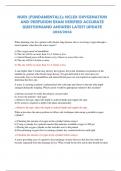Exam (elaborations)
NURS (FUNDAMENTALS): NCLEX OXYGENATION AND PERFUSION EXAM VERIFIED ACCURATE QUESTIONSAND ANSWERS LATEST UPDATE 2023/2024
- Course
- Institution
NURS (FUNDAMENTALS): NCLEX OXYGENATION AND PERFUSION EXAM VERIFIED ACCURATE QUESTIONSAND ANSWERS LATEST UPDATE 2023/2024
[Show more]



